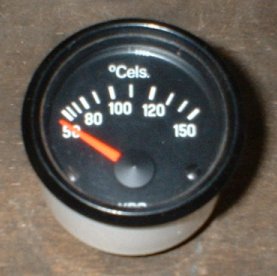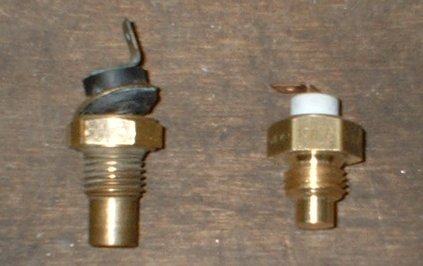


Temperature-gauge, Rev-counter and Indicator lights
At first I wanted to use the rev-counter and temp-gauge out of the original Alfa 33 cockpit. But, when I
took it apart, I discovered it would take a lot of work to make use of the rev-counter and temp-gauge. I would have to create housings
for each of them. I now hooked up the rev-counter signal wire to the little VDO rev-counter I allready had in my bug. I hope
the signal provided by the CPU is the same (4 pulse) signal all rev-countes need. If this wouldn't be the case, Alfa Romeo had to
use a special rev-counter for this model, as this 1.4 only had the Weber injection system. The workshop manual only mentions two
cockpits. One for the carb-models and one for ALL injection models. So, it still can be different...time will tell...
The temp-gauge is another story. The Alfa temp-sender and gauge was made by Veglia. But the temp-sender is broken (this probably
happened when they removed the engine from the car). The temp-gauge I allready had in my bug was a VDO unit with a
temp range of 50 to 150 degrees celsius.

It showed the oil temp when the beetle engine was still in the car. I went to a VDO dealership, and I bought a M14 threaded temp-sender for gauges that go up to 150 degrees:

The one on the left is the original broken Veglia sender, the one on the right is the new VDO sender. They told met
length didn't matter... :-) .
I allready said that the temp-gauge was originally ment for monitoring oil temp. For this I used a dipstick temp-sender. Because
oil temp is also important, and I allready had this thing, I decided to try to use this sender on the Alfa engine. These
are the two dipsticks, the top one is the Alfa dipstick, the bottom one is the beetle one with the sender:

I moved the black plastic thing (which is attached with a little screw) on the beetle dipstick towards the sender-unit. Then I removed the rubber from the Alfa dipstick, and put it on the beetle dipstick:

Then I added some markings on the dipstick to match the level-markings on the Alfa one. And now it fits the Alfa engine.
It is a bit of a reach down to get to it, and I had to bend it a little bit to clear the oil filter, but it does fit nice.
Now I want to make a switch in the dashboard so I can switch the temp-gauge between water-temp and oil-temp.
edit 05-06-2006: I placed three led's in the dashboard, two yellow ones on the left, and one green one on the right:

The two yellow ones are indicating fan-is-switched-on and engine-overheating, the green one indicates that there is power going to the fuel pump.
edit 10-06-2006:Installed a switch to be able to switch between water temp en oil temp. The switch is hidden away under the dashboard.

The little black box above the switch is a safety relay I thought I needed to
switch of the fuel-pump in case of an accident. It turned out the CPU allready did this for me, so it wasn't needed
anymore and I removed it.
I made a wiring diagram to help me while wiring everything. It was a great help, instead of trying to wire it
from my head (and make mistakes..) I could just look at the diagram and be sure how to do it. This is it (click on
it for a bigger version):

Looks nice and simple, doesn't it? This is how it looks in real life:

Wires and upholstery everywhere. I had to route 7 wires from back to front. Three of them were from the heater
and only had to be routed from under the back seat to under the dashboard. But 4 of them had to be routed from the
engine compartment to under the dash. The 4 are for fuel pump, water-temp, overheating-indicator-light and
radiator-fan-on-indicator light. Lots of work, especially because I soldered all the connections and spade-plugs.
This is the finished product:

From left to right: water and oil temperature gauge, rev-counter, top yellow led: engine overheating indicator, bottom yellow led: radiator fan is on indicator, shift pattern :-), green led indicating power to the fuel pump, clock.
edit 13-10-2007: Because of the CPU not giving a standard rev-counter signal, this standard VDO rev-counter didn't work. I now had two choices:
buy a rev-counter that can be switched to two cylinders. Because this engine has wasted sparc ignition each coil fires two times per cycle, instead of four times with a single coil ignition. The two cylinder rev-counter could be wired to one of the coils and it should give a correct reading.
use the original rev-counter from the Alfa 33. The problem is, I'd had to creat my own housing for it.
Because I couldn't find a two cylinder rev-counter cheap enough and I allready had the original Alfa 33 cockpit, it decided
to use the Alfa rev-counter.
This is the original Alfa cockpit:

When you remove the rev-counter you'll see that it is nothing more than a dial with a little bit electronics behind it.
I used a piece of sewer pipe (a piece that allows you to go from 110 mm to 80 mm), a clamp of an old drawing board, two pieces
of acrylic glass, some bits of metal and two bolts (it's beginning to sound like a recipe..):

Now stir it all together..... uhm...no... :-)
I used two bits of alumium to hold the rev-counter into place, on the top there is a piece of iron that connects the
rev-counter housing to the clamp. The clamp will be used to attach it to the underside of the dashboard:


As you can see I allready painted it flat-black. And I added three LED's to make the rev-counter light up.
The connections points are: silver screw top left: + for the LEDS, copper nut top right: + for the rev-counter, middle
copper nut on the right: signal from the CPU, copper nut right bottom: earth for rev-counter and LED's.
And this is what it looks like in the car:

Under the dashboard was the only place there was room for this rev-counter. But I can see it very good through my steering wheel:

In this picture you can also see that I move the temp gauge to the right and place a voltage gauge in the old place of the temp
gauge. This particular voltage gauge isn't working very good, by the way. It gives a way too low reading.
The rev-counter works perfectly, I now discovered I am "only" at 4000 rpm at 80 km/h in third gear! So doing 90 km/h in
third gear is not a real problem, the engine should be able to do 6000 rpm max.


